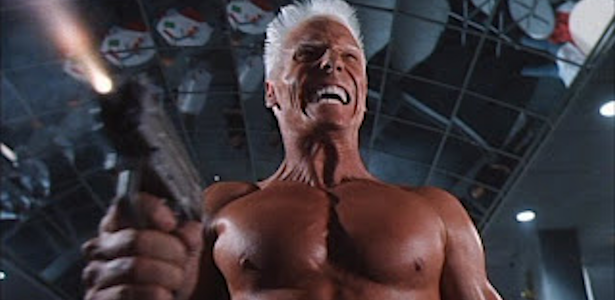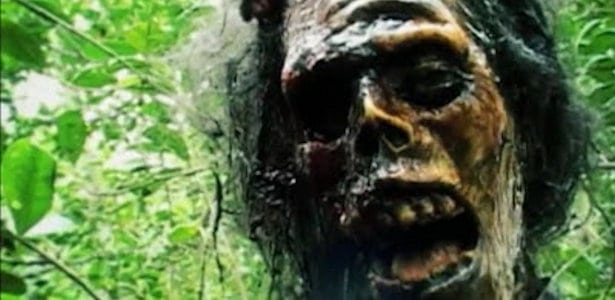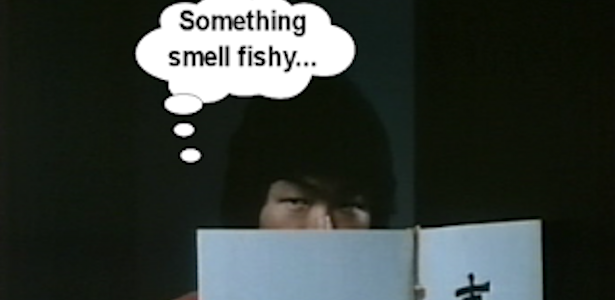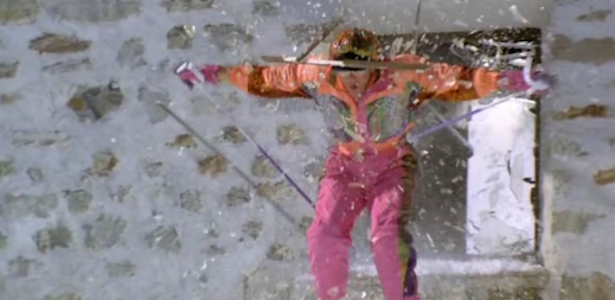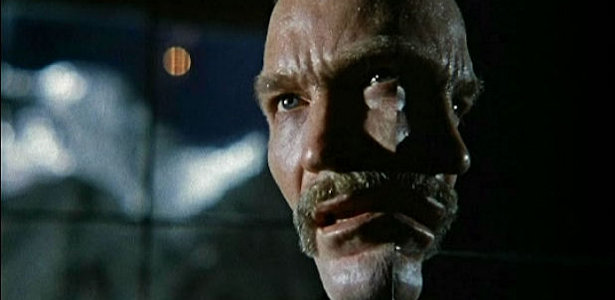“Hell Squad, Hell Squad, We’re the best!" - Hell Squad cadence
Uh, maybe not. Over the last few weeks we’ve covered the unmade screenplays of Don Glut (here are parts one, two, and three). Despite having worked heavily in comics and television animation for over a decade, Glut still didn’t have a theatrical screenwriting credit by the early 1980s. This all looked like it was going to change when he got the job to write HELL SQUAD, a T&A action flick. Yet despite that film actually being made, Glut would still not receive that elusive first big screen credit and HELL SQUAD turned out to be an object lesson in the seedy world of low budget filmmaking in Hollywood.HELL SQUAD opens with scientists examining the fallout area of a bomb test in the desert. It seems the United States has developed the Ultra Neutron Bomb (“The UN Bomb as the President calls it,” says Ambassador Mark, who is never given a last name), a device so strong that it will wipe out anything made of flesh in its radius but leave buildings standing untouched. The logic behind this, according to the Ambassador, is that it will wipe out the warring savages, but leave the cities standing for future generations. Um, that doesn’t make much sense and his son, Jack (Glen Hartford), threatens to expose this horror upon humanity to the press when he gets back to the U.S. Unfortunately for Jack, he is kidnapped just moments later by terrorists who demand the bomb for his safe return. With the U.S. President refusing to intervene, the Ambassador turns to his friend Jim (Walter Cox), whose plan is to train Las Vegas showgirls to be expert commandos so they can go in undercover and rescue the son. Read that last part again and really let it sink in. Should we hire freelance commandos? Nope, let’s get a group whose main training is doing high kicks in heels. Makes sense, right? This guy makes military intelligence an oxymoron.
 Jim flies to Vegas in order to recruit old friend Jan (Bainbridge Scott) as the leader of the mission. In order to test her skills, he sends two guys to hit on her at the bar and she beats the crap out of him. You passed the test. Jim tells the girls he has an important job for them at $500 a week and $25,000 upon return. In 80s money wouldn’t that pay be the equivalent of a grocery
Jim flies to Vegas in order to recruit old friend Jan (Bainbridge Scott) as the leader of the mission. In order to test her skills, he sends two guys to hit on her at the bar and she beats the crap out of him. You passed the test. Jim tells the girls he has an important job for them at $500 a week and $25,000 upon return. In 80s money wouldn’t that pay be the equivalent of a grocery  store chain district manager? Anyway, they have to pass the training and sixteen girls in short shorts show up at a desert obstacle course (consisting of a drain pipe to crawl through, 8 tires, a 3-foot pond, and 6-foot wall to jump over) to vie for this mysterious gig. “We have less than 10 days to transform you from Las Vegas showgirls to expert commando fighters,” says the drill sergeant. The team is eventually whittled down to Jan and 8 ferocious female fighters and they are informed of their mission to save the Ambassador’s son. They are told he is being held in an area near the Syrian border. Arriving as a dance troupe in the Middle East, they relax in a big hot tub before getting a mysterious phone call with their instructions. They raid a castle, but the kidnapped son is nowhere to be found. After this scenario repeats itself a few times, Jan begins to suspect there is a spy in their midst who is using the Hell Squad to get rid of enemies. Will she be able to uncover this mole? And will poor Jack ever be saved?
store chain district manager? Anyway, they have to pass the training and sixteen girls in short shorts show up at a desert obstacle course (consisting of a drain pipe to crawl through, 8 tires, a 3-foot pond, and 6-foot wall to jump over) to vie for this mysterious gig. “We have less than 10 days to transform you from Las Vegas showgirls to expert commando fighters,” says the drill sergeant. The team is eventually whittled down to Jan and 8 ferocious female fighters and they are informed of their mission to save the Ambassador’s son. They are told he is being held in an area near the Syrian border. Arriving as a dance troupe in the Middle East, they relax in a big hot tub before getting a mysterious phone call with their instructions. They raid a castle, but the kidnapped son is nowhere to be found. After this scenario repeats itself a few times, Jan begins to suspect there is a spy in their midst who is using the Hell Squad to get rid of enemies. Will she be able to uncover this mole? And will poor Jack ever be saved?HELL SQUAD opens with a shot of a big bomb going off in the desert. Now as much as I hate to resort to symbolism, that is the perfect image to inaugurate audiences watching this movie. And when you learn about the behind-the-scenes turmoil, you’ll fully understand and be amazed this film even got finished. Glut got the assignment through a filmmaking friend. “Mark Borde said a friend of his named Ken Hartford needed someone to write a script,” he remembers. “All they knew is it was about Las Vegas showgirls who get hired to go into Beirut and rescue the son of an ambassador. Guns, tanks and a lot of sexy girls – warrior women wearing hot pants and berets. It sounded like my kind of movie so I said, ‘Okay, sure.’ What I didn’t know at that time was that [producer-director] Ken Hartford was a notorious crook. That is why he was no longer using his real name of Kenneth Herts. He owed money to just about everybody.”
 |
| "Herts...Hartford...I'm so confused!" |
Glut met with Hartford about the project – which was initially called COMMANDO GIRLS – and contracts were quickly drawn up. Hartford took out huge ads in Variety to tout the production’s beginning in 1983, giving Glut a small indicator of the turmoil to ensue. “My name was on the ad, misspelled with two Ts,” he amusingly recalls.
Glut receives an extra "T":
Despite that ominous black and white omen, Glut got to work on the script. The only provision is he had to include a scene of the girls attacking a castle as Hartford had already shot footage of them doing so (interestingly, this is the same castle where Ted V. Mikels used to live and shoot). Hartford actually started shooting the movie before Glut had finished the script and this didn’t sit well with the writer. Even more dubious, Glut’s initial, agreed upon first payment had not been made. “I had almost written the whole thing, but I had only given him the first two-thirds of it,” he explains of the behind-the-scenes happenings. “I went down to see them shooting the thing. Then it dawned on me that I wasn’t getting paid and he was taking advantage of me. I said I’m not going to give you the rest of the script until you pay me. And he got all bent out of shape over that.”
Ultimately, the matter ended up in court as Glut decided to sue. Hartford tried to suggest Glut had no involvement with the project’s screenplay; going so far as to take out trade ads stating the he, Hartford, was the lone writer (yes, after crediting Glut in the earlier ad). Unfortunately, the producer-director seemed to have forgotten one key piece of evidence. “What he had forgotten though during our big story conference is that he tape recorded it and he gave me the cassettes to use for reference,” Glut explains. “The tape began, ‘Testing one, two, three…hello, this is Ken Hartford and these are the notes that we’re discussing based on the script HELL SQUAD that is being written by Don Glut for my motion picture.’ So we went into court and the first thing we did is went into the judge’s chambers and my lawyer popped the tape in the cassette player and that was it. I won the judgment, but never saw a cent because Ken Hartford had all of his assets protected. I was never able to get any money out of it.”
Hmmmm, something is missing here:
Whether Hartford was just plain dumb or cynical enough to know the system, we’ll never know. But Glut wasn’t the only one screwed out of payment on the feature. Even the film’s leading lady, Bainbridge Scott, ended up in the red on the HELL SQUAD production. “Apparently she didn’t get paid either,” Glut discloses. “She was doing a play a few years later and I talked to her backstage and she had not the best memories of Hartford.”
 |
| "Hello? When am I getting paid?" |
 So what did Hartford do with a film that he only had two-thirds of a script for and no ending? He just wrote it himself, naturally. The film’s last third was written by this anti-auteur and involves the girls being kidnapped by a Shiek with a tiger before they begin their final rescue attempt of Jack, who is held in a European looking castle surrounded by a lake in the middle of the desert. Yes, a lake in the middle of the Middle Eastern desert! Hartford even opts for a Scooby Doo ending where the spy is unmasked by tearing off their fake face. You see, it was the Ambassador’s secretary the whole time and she was actually a he. This leads the dumbstruck diplomat to exclaim, “I’m shocked! It just goes to show you can work with a person and never really get to know them.” It is a stark contrast to Glut’s script. While he freely admits the screenplay is no work of art, Glut at least gave it a breezy, tongue-in-cheek approach, which is probably best for a film about Las Vegas showgirls turned commandos. For example, how can you not love a hot tub scene that is predicated on a girl saying she read about a water shortage in that country so they should all take a bath at the same time?
So what did Hartford do with a film that he only had two-thirds of a script for and no ending? He just wrote it himself, naturally. The film’s last third was written by this anti-auteur and involves the girls being kidnapped by a Shiek with a tiger before they begin their final rescue attempt of Jack, who is held in a European looking castle surrounded by a lake in the middle of the desert. Yes, a lake in the middle of the Middle Eastern desert! Hartford even opts for a Scooby Doo ending where the spy is unmasked by tearing off their fake face. You see, it was the Ambassador’s secretary the whole time and she was actually a he. This leads the dumbstruck diplomat to exclaim, “I’m shocked! It just goes to show you can work with a person and never really get to know them.” It is a stark contrast to Glut’s script. While he freely admits the screenplay is no work of art, Glut at least gave it a breezy, tongue-in-cheek approach, which is probably best for a film about Las Vegas showgirls turned commandos. For example, how can you not love a hot tub scene that is predicated on a girl saying she read about a water shortage in that country so they should all take a bath at the same time? |
| "Try shooting from the hip." |
Post-script: Interestingly, Hartford’s son Glen, who essayed the role of the kidnapped son in HELL SQUAD, followed in his father’s fraudulent filmmaking footsteps, but with much more dire consequences. You can read all about it at this link.




